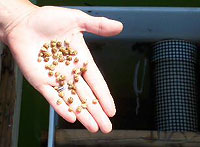Journals 2003/2004
Margaret Brumsted
Dartmouth High School, Dartmouth, Massachusetts
"North Cape Shellfish Restoration Project"
Point Judith, Rhode Island
July 21 - August 28, 2003
|
DAY 2: Tuesday July 22, 2003
One of the three shellfish restoration projects currently underway at the Matunuck facility involves the nursery culture of quahogs (Mercenaria mercenaria). Karin felt that this would be a very beneficial project for me to take on and it would also be a great help to her. Currently there are an estimated 1.4 million baby quahogs residing in an upweller securely attached to the dock at the North Cape Shellfish Restoration facility. My research will involve tracking the growth rates of different size groups of quahogs. It is important to determine the cumulative instantaneous growth rates in order to be better able to make decisions on stocking densities.
 The quahogs were purchased from a commercial shellfish hatchery, Aquaculture Research Corporation, located on Cape Cod. The total volume of quahogs purchased was 15 liters. These quahogs were placed in an upweller on July 3, 2003. At that time they averaged 2mm in length. The correct term for shellfish at this stage of their development is seed.
Today there are MANY, MANY, MANY liters of the quahogs and they are ready to be screened and sorted into size classes. In order to do this each bin is emptied into a fish tote (large plastic tote) and about a liter of quahogs are placed into a set of graduated screen sieves. They are sorted into three size classes simply called small, medium and large for now. Later on size classifications will be based on sieve size. The bins are scrubbed and power washed in order to remove the assortment of biota that has found the bin to be an excellent substrate for attachment. After several bins are sorted we placed the individual size groups into separate bins.
In order to estimate the number of newly sorted quahogs in each bin we measured out three 10ml quantities of the seed. Each 10ml was carefully counted and an average was taken. The total volume of quahog seed in each bin was measured in liters as we returned the seed to the bins.
For growth rate studies shell measurements are required. Seed size is determined by using vernier calipers and measuring three groups of 50 quahog seed at the quahog's longest length. All of this data will be entered on a spread sheet and analyzed later.
At some point this summer as the seed out grow the upweller; half of the stock will be transferred to an upweller at Roger Williams University. Growth rates may then be compared between Mt. Hope Bay and the Great Salt Pond.
Of the 8 million dollars, 1.5 million dollars were earmarked for shellfish restoration projects. Over the course of five years millions of oysters, quahogs and scallops will be transplanted to designated sites in Narragansett Bay and the coastal ponds.
Currently, Karin and her staff are overseeing three shellfish restoration projects involving oysters (Crassostrea virginica), bay scallops (Argopecten irradians) and quahogs (Mercenaria mercenaria). Karin would like me to learn about and help with all three projects and would especially like me to help out with the quahogs.
Part of my job for today was to help move many remotely set oysters currently residing in shellbags. The oyster nursery is located off the dock and there are an estimated one half million spat sized oysters that have set on sea clam or quahog shell.
|